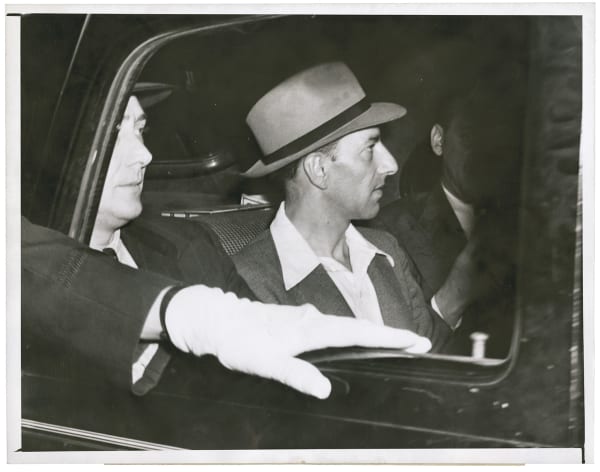The Human Touch, 1935-1945: Weegee
Anton Kern Gallery is pleased to present a solo exhibition of vintage photographs by the American photographer Weegee (b.1899 - d.1968).
Weegee (Arthur Fellig) was born in the Eastern European town of Zolochev, in present-day Ukraine. In 1909, at age ten, he and his family emigrated to New York City via Ellis Island. In his early teens, Weegee began a life-long love affair with the camera, a novel consumer technology at the time. At age fourteen, he dropped out of school and left home, determined to make a living as a photographer.
He started hustling on the hardscrabble streets of the Lower East Side, photographing children posed on his pony, Hypo, and selling the tintypes to their parents. When that enterprise was no longer tenable, he took on various menial roles at photo studios, newspapers and agencies, learning the technical aspects of the medium, ultimately becoming a master of the darkroom.
In the mid-1930s he struck out on his own, eager to make a name for himself as a freelance photographer. Weegee specialized in working the night beat, and in the mornings, he peddled his images to The Herald Tribune, The Sun, The Post, and most consistently Acme photo service. He was rarely credited by name, but his signature style spoke for itself.
Weegee is best-known for his sensational reportage--capturing the immediate aftermath of car crashes, murders, suicides, robberies, fires, gambling raids, and all manner of salacious scenes. Legend has it that he earned his nickname due to his uncanny ability to seek out these extraordinary moments, as if he had a sixth sense-- a kind of human Ouija board. Weegee took as much care crafting his larger-than-life persona as he did his images— adopting that name: “Weegee” and later “Weegee The Famous”.
Weegee was a naturally nocturnal person with a flair for the dramatic that only a city like New York could satiate. He stationed himself nearby his local precinct on Centre Street, following police and emergency workers as they were called to respond, always at the ready with his Speed Graphic press camera. This proximity, and familiarity with police procedures, gave Weegee a time advantage, enabling him to be the first photographer on the scene. In 1938, he became the only freelance news photographer with a permit for a portable shortwave police radio, which meant that sometimes he arrived even before the authorities.
His choice of shots and perspective --- not only shooting the graphic action, but also the surrounding crowd’s reaction --- elevated his photography beyond the typical reporting of the day. Weegee pushed the narrative and emotional potential of the photographic image, creating an art form. Ultimately, he crossed over from the news arena to fine art, exhibiting at The Photo League and the Museum of Modern Art as early as the 1940s, and earning a retrospective at the International Center of Photography in 1998.
The works on view in the exhibition are silver gelatin prints on glossy fibre paper dating from just before and during World War II, 1937 - 1945. Among examples from his crime reporting, this selection also highlights Weegee's documentary photography; capturing everyday New Yorkers in their casual moments. Weegee’s creativity and love for city life imbues these images with a human touch. His subjects include a young girl sharing ice cream with her dog, workers unloading government supplied potatoes, neighbors toasting at the local bar, celebrations in the streets and the cleanup crews afterwards. Together these images illustrate a slice of life during wartime, showcasing American endurance and patriotism across economic and ethnic lines.
-
 Weegee2 Arrested in Radio City Lift Strike, 1943
Weegee2 Arrested in Radio City Lift Strike, 1943 -
 WeegeeA Youngster Offers A Prayer, 1945
WeegeeA Youngster Offers A Prayer, 1945 -
 WeegeeAttend Harlem Party, 1943
WeegeeAttend Harlem Party, 1943 -
 WeegeeBooked for Homicide, 1942
WeegeeBooked for Homicide, 1942
-
 WeegeeCloseup of a Hit and Run Victim, 1937
WeegeeCloseup of a Hit and Run Victim, 1937 -
 WeegeeDogs Get Hot Too, 1943
WeegeeDogs Get Hot Too, 1943 -
 WeegeeHere's a Toast at Mott Street Café, 1943
WeegeeHere's a Toast at Mott Street Café, 1943 -
 WeegeeHusband of Slain Woman, 1937
WeegeeHusband of Slain Woman, 1937
-
 WeegeeKeeping Cool, 1945
WeegeeKeeping Cool, 1945 -
 WeegeeKidnap Victim Returns Home, 1943
WeegeeKidnap Victim Returns Home, 1943 -
 WeegeeMen In White, 1943
WeegeeMen In White, 1943 -
 WeegeeMiss Elisabeth Ross Joined in the Celebration Touched off by the Premature Announcement, 1945
WeegeeMiss Elisabeth Ross Joined in the Celebration Touched off by the Premature Announcement, 1945
-
 WeegeeNew Year's Eve on Broadway, 1940
WeegeeNew Year's Eve on Broadway, 1940 -
 WeegeePost-Celebration Duty, 1945
WeegeePost-Celebration Duty, 1945 -
 WeegeePotatoes:16.100 Pounds of 'Em, 1943
WeegeePotatoes:16.100 Pounds of 'Em, 1943 -
 WeegeePremature Celebration, 1945
WeegeePremature Celebration, 1945
-
 WeegeeThey're Dancing in the Streets!, 1945
WeegeeThey're Dancing in the Streets!, 1945 -
 WeegeeTwelve O,Clock - And All's Closed, 1945
WeegeeTwelve O,Clock - And All's Closed, 1945 -
 WeegeeWeegee says: Good News - Bad Omen, 1944
WeegeeWeegee says: Good News - Bad Omen, 1944 -
 WeegeeWeegee says: Higher Education Goes To Her Head, 1941
WeegeeWeegee says: Higher Education Goes To Her Head, 1941




































